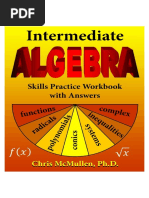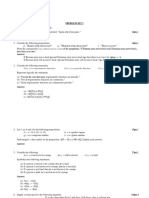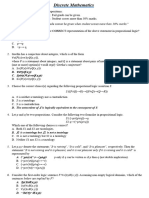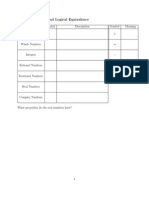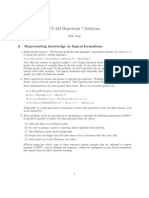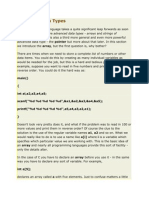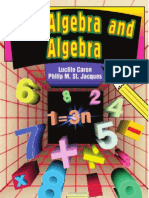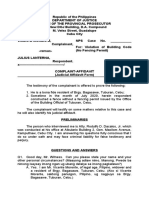Assignment 1 Sol
Uploaded by
Joey Ramirez MarasiganAssignment 1 Sol
Uploaded by
Joey Ramirez MarasiganCOMP 1805 Discrete Structures Assignment 1
Due Tuesday, May 17thth , 2011 at break (before 7:30pm)
Write down your name and student number on every page. The questions should be answered in order and your assignment sheets must be stapled, otherwise the assignment will not be marked. Total marks are 36. 1. (2 marks) For each of the following statements identify if the statement is a proposition, and if so what is its truth value? (a) 1 + 2 = 3 (b) Good work! (c) 7 is an even number. (d) x + y = 4 Marks: 1/2 mark for each statement. No marks for propositions if truth value is not correctly indicated. Solution: (a) Yes, true. (b) No - not declarative. (c) Yes, false. (d) No - since it is neither true nor false. 2. (4 marks) Answer the following questions. (a) What is the converse of, I go to the beech whenever it is warm. (b) What is the inverse of, If pigs can y then I will go to a Justin Beiber concert. (c) What is the contrapositive of, It is raining implies it is cloudy. (d) What is the negation of, I like shing but I do not like hunting. Marks: 1 mark each. Solution: (a) This statement is of the form p whenever q which is equivalent to p q. So we let p be the proposition It is warm and q be the proposition I go to the beech. So this statment could be read If it is warm then I go to the beech. We want the converse of this statement which is q p, which we can write as If I go to the beech then it is warm. (b) This is more straightfoward. We can let p be the proposition Pigs can y and q be the proposition I go to the Justin Beiber concert., so we have p q. We want the inverse of this, which is p q which we can write as If pigs cannot y then I will not go to the Justin Beiber concert. (c) If we let p be the proposition It is raining, and q be the proposition It is cloudy and our original implication is p q. The contrapositive of this statement is q p which we read If it is not cloudy then it is not raining..
COMP 1805
A SSIGNMENT 1
(d) This statement is not a implication but a conjunction (where but is used in the place of and). So our propositions are p is I like shing and q is I like hunting, so our compound proposition is p q. We use De Morgans law to gure out the negation of this statement: (p q) p q p q
Which we read as I do not like shing or I like hunting. 3. (3 marks) Let a be the proposition It is summer, b be the proposition I go to the cottage, and c the proposition I study Discrete Math. Express the following compound propositional statements as English sentences. (a) b a Solution (1 mark): I will go to the cottage if and only if it is summer. (b) a (b c) Solution (1 mark): If it is summer then I will go to the cottage and study Discrete Math1 (c) (b c) a Solution (1 mark): I will not go to the cottage or I will not study Discrete Math, and it is summer. Alternately using De Morgans law you could say It is not the case that I will go to the cottage and study discrete math, and it is summer. (This is (b c) a. 4. (2 marks) Determine whether or not the associative law holds for (exclusive or). Marks: 2 marks. They can show this by other methods other than a truth table. Solution: We use a truth table to demonstrate that the associative law applies for exclusive or. a T T T T F F F F b T T F F T T F F c T F T F T F T F (a b) c T F F T F T T F a (b c) T F F T F T T F
Therefore, since the truth values in the columns for (a b) c and a (b c) are identical for all combinations of the input variables, the associative law applies for exclusive or. 5. (5 marks) Translate the following English statements into propositional logic. Dene the propositions you will use. Your base propositions should not be negative or compound propositions themselves. Use brakcets when necessary to make the order of evaluation clear. (a) If I study Discrete Math and Linear Algebra then I will get good grades. Solution (1 mark): p: I study Discrete Math q: I study Linear Algebra r: I will get good grades Statement is (p q) r.
1 What
fun!
COMP 1805
A SSIGNMENT 1
(b) The sky is blue or the earth is round. Solution (1 mark): b: The sky is blue. r: The earth is round. Statement is b r. (c) It is Monday and I am not at work. Solution (1 mark): m: It is Monday. w: I am at work. Statement is m w. (d) I will live to be 100 years old iff I excercise every day and I eat well. Solution (1 mark): p: I will live to be 100 years old. q: I exercise every day. r: I eat well. Statement is p (q r). (e) I miss the bus if I sleep in. Solution (1 mark): p: I miss the bus. q: I sleep in. Statement is q p. 6. (2 marks) Consider the implication If the stock market is up then I will invest my money. For each of the following cases state if this implication is true, and why. (a) The market is down and I do not invest my money. Solution (1/2 mark): True, market is down so the hypothesis of our implication is False and therefore the implication is true regardless of what the value of the conclusion is. (b) The market is up and I do not invest my money. Solution (1/2 mark): False, market is up so the hypothesis of our implication is True and therefore the conclusion must be true in order that the implication be true. However, in this case the conclusion is false since I did not invest. (c) The market is down and I invest my money. Solution (1/2 mark): True, market is down so the hypothesis of our implication is False and therefore the implication is true regardless of what the value of the conclusion is. (d) The market is up and I invest my money. Solution (1/2 mark): True, the hypothesis and conclusion are both true, so the implication is true. 7. (10 marks) Determine if the following are tautologies, contradictions or contingencies. Use a truth table or logical equivalences as indicated. (a) (a b) (a b) (use a truth table). Solution (2 marks): This is a tautology.
COMP 1805
A SSIGNMENT 1 a T T F F b T F T F ab T F F F ab T T T F (a b) (a b) T T T T
(b) (a b) (a b) (use logical equivalences ). Solution (2 marks): The expression is a contradiction. (a b) (a b) (a b) (a b) (a b) (a b) F De Morgans Law Double Negation Law Negation Law
Therefore, the expression is logically equivalent to F and is thus a contradiction. (c) (c b) (c b) (use logical equivalences ). Solution (2 marks): The expression is a contradiction. (c b) (c b) (b c) (c b) (b c) (b c) (b c) (b c) F Contrapositive Commutative Implication Equivalence Negation Law
Therefore, the expression is logically equivalent to F and is thus a contradiction (d) (a b) ((a b) (a b)) (use a truth table) Solution (2 marks): This is a contingency. Let X = a b, Y = a b and Z = (a b). The statement is thus X (Y Z). a T T F F b T F T F a F F T T b F T F T X F T T T Y T T T F Z F F T F Y Z F F T F X (Y Z) T F T F
(e) Use logical equivalences to show that the rule of inference, modus ponens is a tautology. The rule is expressed as: [p (p q)] q. Solution (2 marks): There may be shorter ways to arrive at this, but the following works: [p (p q)] q [p (p q)] q [p (p q)] q [p (p q)] q [p (p q)] q [p (p q)] q [(p p) (p q)] q [T (p q)] q (p q) q p (q q) p T T Implication Equivalence De Morgans Implication Equivalence De Morgans Double Negation Distributive Law Negation Law Identity Law Associative Law Negation Law Domination
COMP 1805
A SSIGNMENT 1
8. 2 marks Translate the following statements into English where W (x) is x has wings, F (x) is x can y, and Q(x) is x quacks, and the domain is all animals. (a) x(W (x) F (x)). Solution (1 mark): There exists an animal with wings that cannot y. (b) x [(W (x) Q(x)) F (x)]. Solution (1 mark): All animals that have wings and quack can y. 9. 2 marks Give the negation of the following statement. The negation symbols should proceed the predicates. xyz [A(x, y) (B(x, y) C(x, y))] Solution (1 mark): xyz [A(x, y) (B(x, y) C(x, y))] xyz [A(x, y) (B(x, y) C(x, y))] xyz [A(x, y) B(x, y) C(x, y)] xyz [A(x, y) B(x, y) C(x, y)]
Implication Equivalence De Morgans
10. 6 marks Let H(x) be x plays hockey, S(x) be x can skate, D(x) be x can dance and E(x) be x earns money. The universe of discourse is all humans. State the following logically. (a) Everyone that can skate and dance earns money. Solution (2 marks): x(S(x) D(x) E(x)) (b) At most two people can play hockey and dance. Solution (2 marks): (xyz((H(x) D(x)) (H(y) D(y)) (H(z) D(z)) (x = y) (y = z) (x = z)). By applying DeMorgans Law, we see that this is equivalent to all the following statements: i. x(yz((H(x) D(x)) (H(y) D(y)) (H(z) D(z)) (x = y) (y = z) (x = z))). ii. xy(z((H(x) D(x)) (H(y) D(y)) (H(z) D(z)) (x = y) (y = z) (x = z))). iii. xyz((H(x) D(x)) (H(y) D(y)) (H(z) D(z)) (x = y) (y = z) (x = z))). (c) Not everyone who plays hockey earns money. Solution (2 marks): (x(H(x) E(x))). By DeMorgans, we see that this is also equivalent to x(H(x) E(x))
You might also like
- The Art of Problem Solving Intermediate Algebra96% (25)The Art of Problem Solving Intermediate Algebra720 pages
- Beginner's Step-By-Step Coding Course Learn Computer Programming The Easy Way, UK Edition98% (46)Beginner's Step-By-Step Coding Course Learn Computer Programming The Easy Way, UK Edition360 pages
- The Motivational Interviewing Workbook - Exercises To Decide What You Want and How To Get There100% (10)The Motivational Interviewing Workbook - Exercises To Decide What You Want and How To Get There224 pages
- Golf Strategies - Dave Pelz's Short Game Bible PDF92% (24)Golf Strategies - Dave Pelz's Short Game Bible PDF444 pages
- Catherine V Holmes - How To Draw Cool Stuff, A Drawing Guide For Teachers and Students97% (35)Catherine V Holmes - How To Draw Cool Stuff, A Drawing Guide For Teachers and Students260 pages
- [Algebra Essentials Practice Workbook with Answers Linear and Quadratic Equations Cross Multiplying and Systems of Equations Improve your Math Fluency Series] Chris McMullen - Algebra Essentials Practice Workbook with A.pdf80% (10)[Algebra Essentials Practice Workbook with Answers Linear and Quadratic Equations Cross Multiplying and Systems of Equations Improve your Math Fluency Series] Chris McMullen - Algebra Essentials Practice Workbook with A.pdf207 pages
- Math 87 Mathematics 8 - 7 Textbook An Incremental Development Stephen Hake John Saxon100% (10)Math 87 Mathematics 8 - 7 Textbook An Incremental Development Stephen Hake John Saxon696 pages
- Self-System Therapy For Depression Client Workbook100% (8)Self-System Therapy For Depression Client Workbook113 pages
- Chris McMullen - Intermediate Algebra Skills Practice Workbook With Answers - Functions, Radicals, Polynomials, Conics, Systems, Inequalities, and (2021, Zishka Publishing) - Libgen - Li100% (3)Chris McMullen - Intermediate Algebra Skills Practice Workbook With Answers - Functions, Radicals, Polynomials, Conics, Systems, Inequalities, and (2021, Zishka Publishing) - Libgen - Li502 pages
- GATE_2024_Physics_Solutions_4f152e927bd30c4fe942a93d17cd075fNo ratings yetGATE_2024_Physics_Solutions_4f152e927bd30c4fe942a93d17cd075f20 pages
- Discrete Mathematics and Its Applications: Exercise BookNo ratings yetDiscrete Mathematics and Its Applications: Exercise Book84 pages
- DMMR Tutorial Sheet 1: Propositional Logic, Predicate Logic, Proof Techniques September 19th, 2019No ratings yetDMMR Tutorial Sheet 1: Propositional Logic, Predicate Logic, Proof Techniques September 19th, 20193 pages
- HW 1 Solutions: Compsci 102 Discrete Mathematics For Cs Spring 2006 ForbesNo ratings yetHW 1 Solutions: Compsci 102 Discrete Mathematics For Cs Spring 2006 Forbes6 pages
- EECS 203: Discrete Mathematics Fall 2019 Discussion 1 Notes: 1 DefinitionsNo ratings yetEECS 203: Discrete Mathematics Fall 2019 Discussion 1 Notes: 1 Definitions4 pages
- 2.1 Logical Form and Logical Equivalence: Irrational NumbersNo ratings yet2.1 Logical Form and Logical Equivalence: Irrational Numbers9 pages
- Module Code MA4001: Logic and Problem Solving Tutorial: Week 1No ratings yetModule Code MA4001: Logic and Problem Solving Tutorial: Week 13 pages
- De Moiver's Theorem (Trigonometry) Mathematics Question BankFrom EverandDe Moiver's Theorem (Trigonometry) Mathematics Question BankNo ratings yet
- 10+2 Level Mathematics For All Exams GMAT, GRE, CAT, SAT, ACT, IIT JEE, WBJEE, ISI, CMI, RMO, INMO, KVPY Etc.From Everand10+2 Level Mathematics For All Exams GMAT, GRE, CAT, SAT, ACT, IIT JEE, WBJEE, ISI, CMI, RMO, INMO, KVPY Etc.No ratings yet
- Trigonometric Ratios to Transformations (Trigonometry) Mathematics E-Book For Public ExamsFrom EverandTrigonometric Ratios to Transformations (Trigonometry) Mathematics E-Book For Public Exams5/5 (1)
- Salapungan National High School: Salapungan, San Rafael, BulacanNo ratings yetSalapungan National High School: Salapungan, San Rafael, Bulacan1 page
- Efficient and Not Efficient Way of Repairing Damage Program of CellphonesNo ratings yetEfficient and Not Efficient Way of Repairing Damage Program of Cellphones23 pages
- Florida Teacher Certificate Examinations (FTCE) Study Guide0% (2)Florida Teacher Certificate Examinations (FTCE) Study Guide20 pages
- Discrete Structures: Introduction To ProofsNo ratings yetDiscrete Structures: Introduction To Proofs31 pages
- 1 Propositional Logic - Axioms and Inference RulesNo ratings yet1 Propositional Logic - Axioms and Inference Rules22 pages
- Dampak Relokasi Pasar Terhadap Ekonomi Pedagang IkNo ratings yetDampak Relokasi Pasar Terhadap Ekonomi Pedagang Ik17 pages
- Logical Structures Lecture 1. Declarative Sentences and Natural DeductionNo ratings yetLogical Structures Lecture 1. Declarative Sentences and Natural Deduction78 pages
- Beginner's Step-By-Step Coding Course Learn Computer Programming The Easy Way, UK EditionBeginner's Step-By-Step Coding Course Learn Computer Programming The Easy Way, UK Edition
- The Motivational Interviewing Workbook - Exercises To Decide What You Want and How To Get ThereThe Motivational Interviewing Workbook - Exercises To Decide What You Want and How To Get There
- Golf Strategies - Dave Pelz's Short Game Bible PDFGolf Strategies - Dave Pelz's Short Game Bible PDF
- Catherine V Holmes - How To Draw Cool Stuff, A Drawing Guide For Teachers and StudentsCatherine V Holmes - How To Draw Cool Stuff, A Drawing Guide For Teachers and Students
- [Algebra Essentials Practice Workbook with Answers Linear and Quadratic Equations Cross Multiplying and Systems of Equations Improve your Math Fluency Series] Chris McMullen - Algebra Essentials Practice Workbook with A.pdf[Algebra Essentials Practice Workbook with Answers Linear and Quadratic Equations Cross Multiplying and Systems of Equations Improve your Math Fluency Series] Chris McMullen - Algebra Essentials Practice Workbook with A.pdf
- Math 87 Mathematics 8 - 7 Textbook An Incremental Development Stephen Hake John SaxonMath 87 Mathematics 8 - 7 Textbook An Incremental Development Stephen Hake John Saxon
- Self-System Therapy For Depression Client WorkbookSelf-System Therapy For Depression Client Workbook
- Chris McMullen - Intermediate Algebra Skills Practice Workbook With Answers - Functions, Radicals, Polynomials, Conics, Systems, Inequalities, and (2021, Zishka Publishing) - Libgen - LiChris McMullen - Intermediate Algebra Skills Practice Workbook With Answers - Functions, Radicals, Polynomials, Conics, Systems, Inequalities, and (2021, Zishka Publishing) - Libgen - Li
- GATE_2024_Physics_Solutions_4f152e927bd30c4fe942a93d17cd075fGATE_2024_Physics_Solutions_4f152e927bd30c4fe942a93d17cd075f
- Discrete Mathematics and Its Applications: Exercise BookDiscrete Mathematics and Its Applications: Exercise Book
- DMMR Tutorial Sheet 1: Propositional Logic, Predicate Logic, Proof Techniques September 19th, 2019DMMR Tutorial Sheet 1: Propositional Logic, Predicate Logic, Proof Techniques September 19th, 2019
- HW 1 Solutions: Compsci 102 Discrete Mathematics For Cs Spring 2006 ForbesHW 1 Solutions: Compsci 102 Discrete Mathematics For Cs Spring 2006 Forbes
- EECS 203: Discrete Mathematics Fall 2019 Discussion 1 Notes: 1 DefinitionsEECS 203: Discrete Mathematics Fall 2019 Discussion 1 Notes: 1 Definitions
- 2.1 Logical Form and Logical Equivalence: Irrational Numbers2.1 Logical Form and Logical Equivalence: Irrational Numbers
- Module Code MA4001: Logic and Problem Solving Tutorial: Week 1Module Code MA4001: Logic and Problem Solving Tutorial: Week 1
- A-level Maths Revision: Cheeky Revision ShortcutsFrom EverandA-level Maths Revision: Cheeky Revision Shortcuts
- De Moiver's Theorem (Trigonometry) Mathematics Question BankFrom EverandDe Moiver's Theorem (Trigonometry) Mathematics Question Bank
- 10+2 Level Mathematics For All Exams GMAT, GRE, CAT, SAT, ACT, IIT JEE, WBJEE, ISI, CMI, RMO, INMO, KVPY Etc.From Everand10+2 Level Mathematics For All Exams GMAT, GRE, CAT, SAT, ACT, IIT JEE, WBJEE, ISI, CMI, RMO, INMO, KVPY Etc.
- Trigonometric Ratios to Transformations (Trigonometry) Mathematics E-Book For Public ExamsFrom EverandTrigonometric Ratios to Transformations (Trigonometry) Mathematics E-Book For Public Exams
- Salapungan National High School: Salapungan, San Rafael, BulacanSalapungan National High School: Salapungan, San Rafael, Bulacan
- Efficient and Not Efficient Way of Repairing Damage Program of CellphonesEfficient and Not Efficient Way of Repairing Damage Program of Cellphones
- Florida Teacher Certificate Examinations (FTCE) Study GuideFlorida Teacher Certificate Examinations (FTCE) Study Guide
- 1 Propositional Logic - Axioms and Inference Rules1 Propositional Logic - Axioms and Inference Rules
- Dampak Relokasi Pasar Terhadap Ekonomi Pedagang IkDampak Relokasi Pasar Terhadap Ekonomi Pedagang Ik
- Logical Structures Lecture 1. Declarative Sentences and Natural DeductionLogical Structures Lecture 1. Declarative Sentences and Natural Deduction























